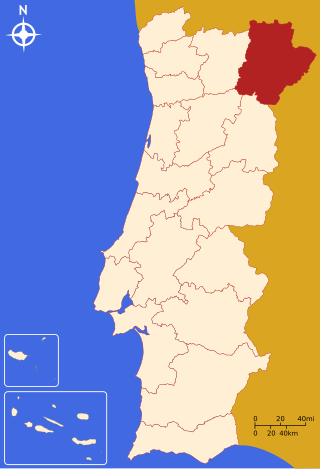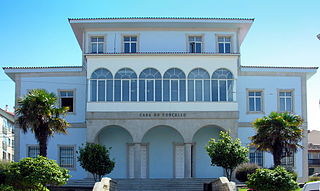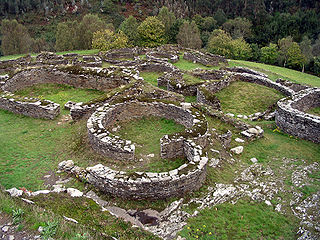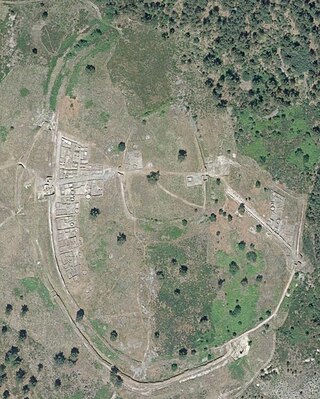
Galicia is an autonomous community of Spain and historic nationality under Spanish law. Located in the northwest Iberian Peninsula, it includes the provinces of A Coruña, Lugo, Ourense, and Pontevedra.

Galician–Portuguese, also known as Old Galician–Portuguese, Old Galician or Old Portuguese, Medieval Galician or Medieval Portuguese when referring to the history of each modern language, was a West Iberian Romance language spoken in the Middle Ages, in the northwest area of the Iberian Peninsula. Alternatively, it can be considered a historical period of the Galician, Fala, and Portuguese languages.

Vila Nova de Famalicão is a Portuguese town with a population of approximately 133,048 inhabitants in an area of 201,59 km2, subdivided into 49 parishes. Inserted in the Braga District, in the North Region of Portugal and in the Sub-Region of Vale do Ave, global positioned at 41⁰24’36” N | 8⁰31’13.53” W. The population of Vila Nova was created in 1205 with the charter given by the King Sancho I. The municipality was created in 1835 as a detachment from Barcelos and was elevated to the category of “Vila” with the charter given by the Queen D. Maria II. In 1985, approved by National Assembly, Vila Nova de Famalicão was elevated to the category of "city". The inhabitants of Famalicão are called Famalicenses.

Tui is a municipality in the province of Pontevedra, in the autonomous community of Galicia, Spain. It is located in the comarca of O Baixo Miño on the right bank of the Miño River, facing the Portuguese town of Valença. The municipality of Tui is composed of 11 parishes: Randufe, Malvas, Pexegueiro, Areas, Pazos de Reis, Rebordáns, Ribadelouro, Guillarei, Paramos, Baldráns and Caldelas.

The Galician or Galician Mountain Horse, Spanish: Caballo de Pura Raza Gallega, Galician: Raza Equina Cabalo Galego do Monte, is a breed of small horse from Galicia, in north-western Spain. It is genetically very close to the Garrano breed of northern Portugal. It was in the past used as a war-horse and in agriculture; it is now raised for shows and riding. They are very useful for ranchwork. The horses are bay or black.

Bragança District is a traditional political division of Portugal, in the northeast corner bordering on Spain, covering 7.4% of the nation's continental landmass. As of the 2011 census the total resident population was 136,252, making it the second-least populous district in Portugal, only surpassing Portalegre District.

The Coelerni were an ancient Celtic tribe of Gallaecia in Hispania, part of Calaician or Gallaeci people, living in what was to become the Roman Province of Hispania Tarraconensis, in what is now the southern part of the province of Ourense.

Monforte de Lemos is a town and municipality in northwestern Spain, in the province of Lugo, Galicia. It covers an area of 200 km2 and lies 62 km from Lugo. As of 2017 it had a population of 18,783.

The Gallaeci were a Celtic tribal complex who inhabited Gallaecia, the north-western corner of Iberia, a region roughly corresponding to what is now the Norte Region in northern Portugal, and the Spanish regions of Galicia, western Asturias and western León before and during the Roman period. They spoke a Q-Celtic language related to Northeastern Hispano-Celtic, called Gallaecian or Northwestern Hispano-Celtic. The region was annexed by the Romans in the time of Caesar Augustus during the Cantabrian Wars, a war which initiated the assimilation of the Gallaeci into Latin culture.

Caminha is a municipality in the north-west of Portugal, 21 km north from Viana do Castelo, located in the Viana do Castelo District. The population in 2011 was 16,684, in an area of 136.52 km².

Castro culture is the archaeological term for the material culture of the northwestern regions of the Iberian Peninsula from the end of the Bronze Age until it was subsumed by Roman culture. It is the culture associated with the Gallaecians and Astures.

Porto do Son is a municipality in the province of A Coruña, in the autonomous community of Galicia, Spain. It belongs to the comarca of Noia. The municipality of Porto do Son encompasses a collection of coastal towns and villages in from including the town of Porto do Son itself, and other towns such as Portosín. The area is around 25 km by 6 km and has many beaches along with some famous Celtic ruins, the castro called the "Castro de Baroña".
Portus Cale was an ancient town and port in present-day northern Portugal, in the area of today's Porto and Vila Nova de Gaia. The name of the town eventually influenced the name of the subsequent country of Portugal, from the 9th century onwards.

Carreira is one of the nine parishes of the municipality of Santa Uxía de Ribeira, Galicia, Spain.

Monte Aloia is a summit in the mountains of Galicia, Spain, which was declared a natural park on 4 December 1978. The park covers an area of 746 hectares and is located within the municipality of Tui, a town on the River Miño.

A castro is a fortified settlement, usually pre-Roman, some from late Bronze Age and Iron Age, associated with Celtic culture. These are frequently found in Northern Spain, particularly in Asturias, Galicia, Cantabria, Basque Country and the province of Ávila, with the Castro culture and on the plateau with Las Cogotas culture.
Castle of Cola is an Iron Age residence and Islamic redoubt in the Portuguese Alentejo, classified as a National Monument. The castro is part of a larger archaeological park of Castro da Cola, that includes various Megalithic and Chalcolithic monuments, including necropolises of the Bronze and Iron Ages. The Castro-era polygonal plan, included reinforced blocks, with an entrance controlled by tower. The remaining defensive structure was circled by walls, with still exist, on the neighboring pasture-lands protecting the castle.

The Galicia–North Portugal Euroregion is a cross-border Euroregion straddling Galicia (Spain) and the North Region (Portugal). It was established in 2008.

The Castro de Baroña is an Iron Age fortified settlement located in the parish of Baroña, a municipality of Porto do Son in the province of A Coruña. The settlement, surrounded by two walls and containing twenty roundhouses that still remain today, was built on a peninsula and inhabited from the 1st Century BC to the 1st Century AD.

San Cibrao de Las hill fort is an archeological site in Galicia, Spain. It is a hill fort of the so-called castro culture. Rather than a single castle, it encompasses an entire fortified town or village.


















